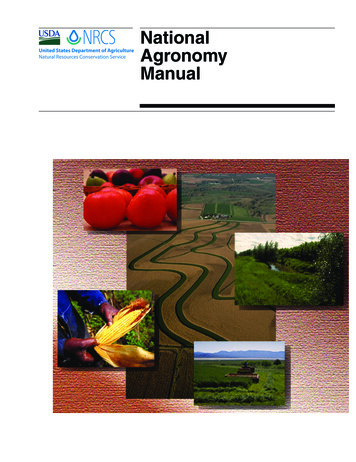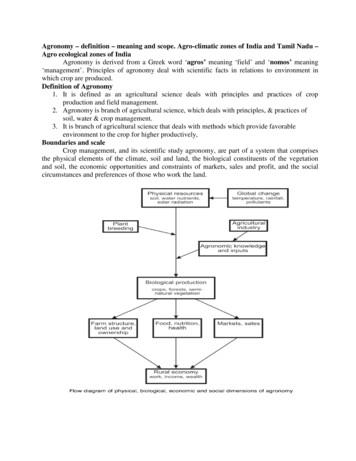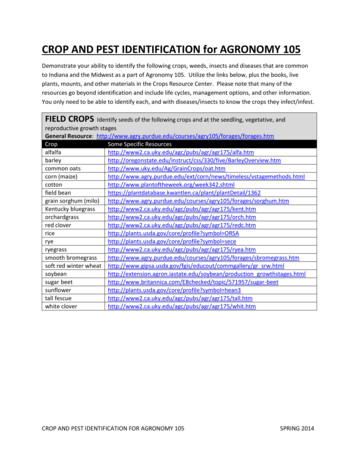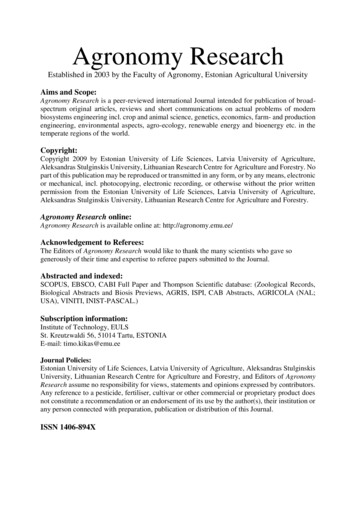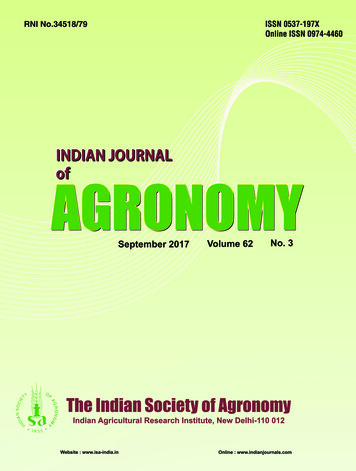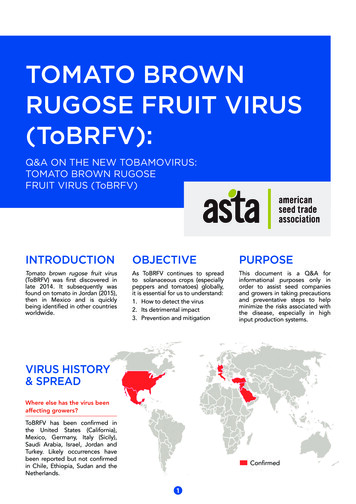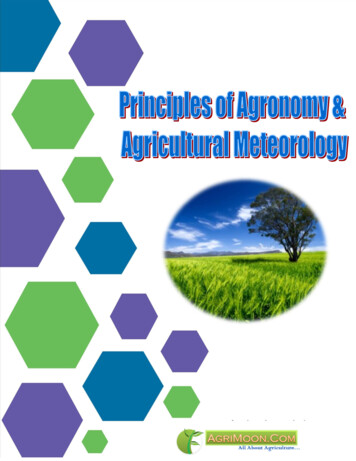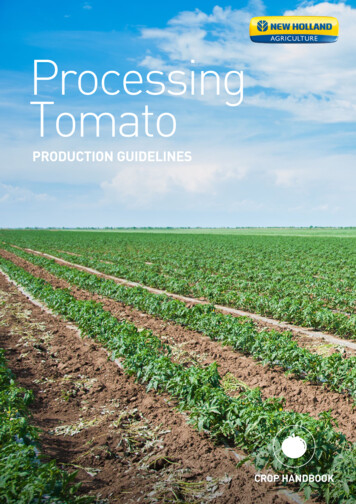
Transcription
ProcessingTomatoPRODUCTION GUIDELINEScrop handbook
Processing TomatoProduction Guidelines3Crop Rotation4Tillage7Transplanting and Transplants9Precision Planting11Crop Protection12Spraying - Hoeing14Fertilization15Irrigation16Mechanical Harvesting17Machinery18crop handbook2
Production GuidelinesProduction GuidelinesProcessing tomatooperationsAGRONOMICS and TIMINGCrop rotationBetter plant (transplant) after winter wheat or other winter cereals. Soybeans also is a good choice, as well as corn silage.Avoid planting (transplanting) after pepper, potatoes and other plants of family nightshade (Solanaceous)Primary tillageDeep primary tillage (35-40 centimeters). Plough first choice, disk ripper an alternativeSecondary tillageTine harrows, power harrows, rotor harrows. PackingPlanting or Transplanting (Northern Hemisphere)Timeliness transplantingfrom March to JuneTimeliness plantingApril to MayDistance between rowsor double rows150 centimeters is more usualDistance between seeds5-6 centimeters, when plantingDistance between transplantsAbout 20 centimeters, when transplantingDepth1.5-3 centimeters when planting; when transplanting, cover the root ballSoil insecticideHighly recommended at planting or transplantingFertilizing (guidelines, to be adjusted on soil analysis base)Nitrogen (N kg/ha)120-250, depending on realistic production targetPhosphorus (P2O5 kg/ha)120-220, depending on soil content in phosphatePotash (K2O kg/ha)0-220, depending on soil contentWeed controlBoth pre transplanting and post emergence recommendedPest controlApplications of fungicides and insecticides by sprayingHarvestingManual or mechanizedDroplet sizes for different chemicalsASABEstandards-572.1 -appliedherbicidecomparativesizeatomizationvery fine (vf)redPointof Needle(25 microns)Fogfine (f)orangeHuman Hair(100 microns)Fine mistmedium (m)yellowSewing Thread(150 microns)Fine Drizzlecoarse (c)blueStample(420 microns)Light Rainvery coarse (vc)greenStample(420 microns)Light Rainextremly coarse(xc) whitesoil-appliedherbiciderelativesize#2 Pencil LeadThunderstorm(2,000 microns)Droplet sizes are suggestions for each pesticide. 1 Based on VDO.5, the Volume Master Diameter (VMD) designation. Source: Kansas City University.2Revision of Stantard S-572.1 also includes extra-fine and ultra-coarse categories for non agricultual users.This droplet guide summarizes suggested droplet sizes for a variety of chemicals, based on the ASABE standard droplet spectrum categories.3
Crop RotationCrop Rotation Crop rotation, as a rule, can improvethe performances of all crops. Tomato belongsto nightshade (Solanaceous) family, like pepper,potatoes, tobacco, and other plants: so, turningwith such crops should be “long” because somediseases are common among these plants(Phytophtora for example). Tomato should notbe grown on the same field within the periodof 4 or, better, 5 years in order to avoid thebuilding up of pathogens Crop Rotations allow the farmer to spread laborintensive operations out throughout the wholeseason, reducing labor and equipmentrequirements peaks. Exploitation of soil fertility is improved, becausedifferent crops roots explore different horizons ofsoil and utilize nutrients at different rates.For example, Soybean enriches the contentof N in soil for following crops and Alfalfamoves nutrients from deep horizons of soilto shallower layers. Structure of soils improves because residuesfrom crop roots stay and decay at different depthsand crop residues have different nutritionalcontents. Management of pests and diseases gets easierbecause different crops have different pests:crop rotation is a powerful mean to avoid or reducedamages. Management of weeds also get easierfor the same reason: for example, controlof monocot weeds (grasses) is much more easyin tomato than in monocot crop as cereals or corn.Tomato development stagesEstablishment4Development& Veg. GrowthFirst Flowering& Fruit SetFirst PhaseFruit Dev.HarvestInitiationFull Harvest
Crop RotationSome data about processing tomato: Italy and USAIn Italy total production in year 2009 has been about5 millions tons from acreage of about 70.000 hectares.Average yield is 70 tons per Hectare. Tomato is croppedeverywhere, but two Regions, Puglia in the South andEmilia in the North produce 85% of crop. the use of effective pesticides in integrated pestmanagement programsIn USA, more than 170.000 hectares of tomatoesare cropped, 95% of which in California.The yearly production exceeds 12.7 million tons,average yield is very like Italy, about 70 tonsper hectare.More recent developments include the use oftransplants and drip irrigation. Since 1990, directseeding has been largely replaced by transplanting.Advantages of transplanting are relatively simplifiedseedbed preparation, better stand establishment,reduced weed competition in early stages of growth. irrigation improved management practices.During the last 20 years, yield increase is the resultof a number of factors, most notably (not in orderof importance)The adoption of drip irrigation during the last decadehas been impressive. While only 2% of the acreagewas under drip irrigation in 2001, this percentagewas 19% in 2003, 33% in 2007 and 78% in 2012.With drip irrigation, yields of 150tons/Ha are notuncommon these days. Of course, also other productionfactors as fertilizing, seeds, crop protection,mechanization and management must be at a veryhigh level. the breeding of more productive hybrids, resistantto bruising and thus suitable for mechanicalharvesting the use of mineral fertilizers based on soil testsand crop requirementsRankCountryProduction year 2012 (metric tons)1China50,000,0002India17,500,0003United ,874,00010Mexico3,433,500World161,800,0005
Crop RotationClimatic (environmental) and soil requirementsTemperatureOptimum soil temperature for processing tomato’sgrowth is 23 C during the day and 15 C at night:flowering is scarce with air temperature above 33 Cand vegetative activity stops above 35 C.The optimum air temperature for fruit ripening isabout 26 C during the day and 18 C at night.Lycopene (the red pigment of which fruits are rich)production stops above 30 C.SoilTomatoes can be produced on a variety of soil types.Obviously, they grow optimally in deep, mediumtextured sandy loam or loamy, fertile,well-drained soils. Avoid sites that tend to stay wetand are subject to ponding. Leveling of fields ishighly recommended, not only for planting but alsofor easy harvesting. In field production, plantsdepend on the soil for physical support andanchorage, nutrients and water. The degree to whichthe soil adequately provides these three factorsdepends upon topography, soil type, soil structureand soil management. Optimum pH is 6.8, thegrowth is scarce with pH above 8. Compaction pansare present in many soils. They are formed mainly,but not only, by machinery and implements trafficand are normally located at or just below plow depths.Although compaction pans may be only a few inches6thick, their inhibitory effects on root growth cansignificantly reduce tomato yields.A good seed bed is important because plant rootsrequire water and oxygen from the soil pore space.A good seed bed is defined as: smooth and level seed bed, without large clodsand weeds good soil tilth, soft structure of seedbed and morefirm deeperThe right soil-air-water balance helps limit plantstress during drought periods and enables the plantto fully explore the soil profile for nutrients.Plants are able to use water efficiently and growstrong roots for good anchorage. At the end tomato,both planted and transplanted needs a very smoothseedbed.
TillageTillagePrimary and secondaryFor tomato production, proper tillage is crucialfor quick and uniform establishment of the cropin initial stages of growth, proper crop stand andthus optimal yields. Land preparation should involveenough tillage operations to get fine soil particlesand make the soil suitable for seedlings ortransplants establishment, providing the best soilstructure for root growth and development.In areas where winter is cold, primary tillage mustbe carried out at fall. Tilled soil winters in coldconditions and clods are sized by frost in an optimalway. Tillage and preparation can take substantialtime and wintering of the fields helps to get propersoil tilth, specially in heavy soils, thus decreasingthe tillage passages in spring.Moldboard plows are currently the main tool forprimary tillage. Tillage systems using the moldboardplow prepare the greatest soft soil volume forvigorous root growth. Fine particles and aggregatesof soil allow the development of more extensive rootsystems, which can more efficiently access nutrientsand water in the soil. Disking after moldboard plowingtends to re compact the soil and should be avoided.Disk rippers can be used as an alternative, forprimary tillage especially where hard pan exists orponding is a problem. Development of root systemis influenced by the soil profile. Root growth will berestricted if there is a hard pan, compacted layer orheavy clay zone. Tomatoes is a deep rooted plantand, under favorable conditions, some roots willgrow to a depth of as much as 10 feet.The majority of roots, however, will be in the upper12 to 24 inches of soil.Since root development is severely limited bycompacted soil, proper land preparation shouldeliminate or significantly reduce soil compactionand hard pans.Secondary tillage is carried out before plantingin spring. The goal is to achieve a proper seedbed,which means soil particles of right size for goodcontact between transplants roots or seeds.Large clods can cause a bad soil to roots contact,so that transplanting machinery does not performin a proper way.Primary tillageA Disk Ripper is an alternative to plough, destroyingcompaction and hard pans. If a compaction panexists just below or near mold-board plow depth,this hard pan can be disrupted by sub soiling toa depth of 16 to 18 inches to allow the developmentof a more extensive root system.Sub soiling also helps increase water infiltration.Summer or fall ploughing is still the most viableoption for tomato cropping. In heavy soils, workingdepth can reach 40 centimeters.Also Chisel Plows can be applied as an alternative tomoulboard ploughs and disk rippers.7
TillageWater management through tillageWe can not manage weather or soil texture. But we can managelevel and tillage of fieldsLevelling fields is recommended on tomato fields, for easier transplanting, irrigation and harvesting.Pondingmisconception: ponding is aresult of too much rainfallNot necessarily. Usually ponding is a result of poorlymanaged soil. When soil is compacted, it cannotabsorb water. Compacted soil is like a sponge thatis squeezed tight: there is no space for air and water.To make matters worse, compacted soil formsan impenetrable layer that prevents excess waterfrom draining through. The result is ponding.8COMPACT SOILnon-COMPACT SOIL
Transplanting and TransplantsTransplanting and TransplantsThe vast majority of processing tomato fieldsare transplanted. Assuming transplantingand not seeding is carried out, tomato will requirefrom 25,000 (USA) to 33,000-35,000 transplants perHa (Italy). Typically, 5 to 6 week old tomato seedlingsare transplanted into the field.As with most similar vegetable crops, container-growntransplants are preferred over bare root plants.Container grown transplants retain transplantgrowing substrate (soil-substitute) attached to theirroots after removal from the container (flat, tray).Many growers prefer this type transplant because they are less subject to transplant shock they usually require little if any replanting they resume growth more quicklyafter transplanting they grow and produce more uniformly.9
Transplanting and TransplantsSeeding tomatoes directly into the field is notrecommended due to the high cost of hybrid seedand the specific conditions required for adequategermination, which are rather difficult to obtain.Most tomatoes are transplanted to the field fromgreenhouse-grown plants. Direct seeding has otherdisadvantages:In most cases, it is more economically feasibleto have transplants produced by a commercialtransplant grower than to grow them on the farm.When purchasing transplants, be sure the plantshave the variety name, have been inspected andapproved by a plant inspection service, and theyare of the size and quality specified in the order.1. because of the shallow planting depth requiredfor tomato seed, the field must be nearly levelto prevent seeds from being washed away orcovered too deeply with water-transported soilSet transplants as soon as possible after removingfrom containers or after pulling. If it is necessary tohold tomato plants for several days before transplantingthem, keep them cool (around 13 C if possible) anddo not allow the roots to dry out prior to transplanting.When setting plants, place them upright and place theroots 3 to 4 inches deep. Setting plants at least as deepas the cotyledons has been shown to enhance plantgrowth and early fruit production and maturity.Completely cover the root ball with soil to preventwicking moisture from the soil. Tomatoes grow best ifnighttime soil temperatures average higher than 15 C.2. harvest dates will be at least 2 to 3 weeks laterfor direct seeded tomatoes3. a thinning is required.For maximum production, transplants should neverhave fruits, flowers or flower buds before transplanting.An ideal transplant is young (6 weeks, 12-14 centimeterstall), does not exhibit an elongated form growth, andis slightly hardened at transplanting time. Rapidgrowth following transplanting helps in assuring awell established plant before fruit development.Transplanting and laying outof drip irrigation linesModern transplanting machinery allowsfor transplanting and at the same time forlaying drip irrigation lines.10After transplanting (especially within the first 2 weeks)it is very important that soil moisture be maintainedso that plant roots can become well established.
Precision PlantingPrecision Planting Planting, as said above, is a second choiceoperation for tomato crops. If such a pattern hasto be implemented, here are some suggestions. Uniformity in tomato is an important factor forhigh yield crops. Producing a high yield crop startswith the right balance between healthy, productiveplants and the plant’s ability to utilize availableresources. Uniformity begins with a well-prepared seed bedand the use of precision vacuum planters. Plants that emerge uniformly or transplantsthat start uniformly after transplanting, progressat the same rate of development throughout thegrowing season and deliver improved yieldpotential. Precision planter is set with inter row spacingof 150 centimeters, spacing between seeds5.8 centimeter to obtain a seed rate of 115,000seeds per hectare. This is the double than thefinal target, but decreasing the seeds rate wouldbe very risky. Granulators for insecticidedistribution are a must on the planter. Seeds are usually pelleted. Seeding depth is 2to 3 centimeters, working speed 4-5km per hour.The final target is 30,000-40,000 plants perhectare, and to get this target a manual thinningis required. Emergence of seedlings requires from15 to 30 days, depending on soil temperatures.11
Crop ProtectionCrop ProtectionCrop protection is of paramount importance, becauseprocessing tomato is used to produce human foodand the quality of fruit is crucial to get good pricefor the product. Diseases, insects, and weeds areserious competitors for crop, and spraying is neededon a regular basis. Weeds and/or pest can damagethe yield up to the 100%, if not controlledor controlled too late.more susceptible to yield losses due to weedcompetition compared to other high-canopy crops.Weeds losses from direct competition are only partof the problems that may be caused by weeds.Weeds as a rule also:Weed control is carried out both with pre-planting(or transplanting), pre-emergence and post emergence(on-top spraying). In pre-emergence, herbicide oftotal action can be used (glyphosate and similar). Inpost emergence, residual herbicides are used againstbroadleaves weeds and graminicides are used againstgrasses.Weeds also make difficult mechanical harvesting.Tomato is not a strong competitor against weeds andmany weeds can grow taller than the crop. Becauseweeds can become taller than the crop, tomato is3. increase tillage needed for weed control.1. produce seed that increases future weed problems2. act as co-hosts for insects and diseasesInsect and diseases control also is carried outby spraying the fields with proper chemicals.For fungi diseases, a spraying is scheduled each10-15 days. Eradication (systemic) and contactfungicides are alternatively applied.Higher working pressures are required in orderto penetrate the crop canopy.In certain areas, ripening chemicals are applied in orderto speed up and make uniform the ripening process.weedsTumble pigweedPalmer amarantFlower headRedroot pigweedProstrate pigweedSeedsPigweedFlower and fruitLeaf hairsSeedlingMature plantLambsquarterDried fruitSeedsSeedlingMature plantVelvet leafSolanum nigrum leafs flowers fruitsby Harald Hubich - photo taken by Harald Hubich.12Flowering stemand leaves
Crop ProtectionInsects and diseasesDowny mildewAphidsBacterial specksCutwormsAlternariaWire worms13
Spraying - HoeingSprayingToolsGuardian Front Boom Sprayers have clearanceand balance which are crucial facts from agronomicpoint of view.Delivering consistent droplet size is a critical partof sprayer operation. This function can be moreimportant depending on which chemical is usedand on what canopy type.HoeingHoeing is an essential operation, and helps with weedcontrol, improving the texture of soil and managinglimited water in dry soil conditions.Hoeing is carried out when the plants have 3-5 leaves.At hoeing is also possible to carry out a top fertilization,if needed. A working depth about 5-8cm helps to kill14weed that have survived herbicides applications(for example nightshade) and interrupts the porosityin the upper layer of soil. Interrupting porosity andclosing surface cracking can help to reducesmoistures losses. Sweeps or spikes can be usedas ground engaging tools.
FertilizationFertilizationFertilization of processing tomato, as for all crops,should be based on soil tests results.Requirements of crop are as follows:Production tons 8090K2O160200240280320360Nutrients, kg /hectareNSo, for example, in condition where soil is rich in potash but poor in Phosphorus and production target is 50 tonper hectare, fertilization plan could be:1. N120total rate divided in two applications2. P2O5120pre transplanting3. K2O0----------------------------------------For maximum production in soils not particularly rich in P205 and K2O:1. N200pre transplanting and top dressing2. P2O5150pre transplanting3. K2O220pre transplantingNutrient absorption timingPhosphorusAfter transplantingPotashFloweringFruit settingRipeningNitrogen15
IrrigationIrrigation Processing tomato is a typical irrigated crop.Different system are possible Surface irrigationWith drip irrigation, starting investments per hectareare higher than with other systems.Anyway, there are some agronomical advantages as fertirrigation, which is the possibility for applyingfertilizer with irrigation water high efficiency of water used in irrigation (lossesof water are very low when compared with otherirrigation systems) high uniformity concerning water height andfertilizers’ rates leaves are not wetted and therefore diseasesspreading is hinderedSprinkler irrigation is carried out both with hosereel systems (on the left) or pivot systems (below),depending on acreage. A large choice of sizesis available both for drums and pivot.16 Drip irrigation Sprinkler irrigation(hose reel irrigators, pivots)
Mechanical HarvestingMechanical HarvestingProcessing tomato is harvested both manually andmechanically, but without doubt a modern agriculturemust be equipped with self propelled or pulledharvesters. Mechanical harvesting is possible becausea complex work has been carried out to obtain:1. proper varieties or hybrids, resistantto mechanical damage (bruising)2. a proper shape and size of fruits3. a relatively uniformity in ripening time.Mechanical harvesting is carried out on 100%of acreage in California and on 70% of acreagein North Italy. New hybrids and increased fertilizing,irrigation and crop protection have also increasedthe yields: mechanical harvesters can be equippedwith sorters, both electro mechanical and electronic.The result is that the labor requirements for harvesthas dropped to 0.4 hour per ton.The productivity of a modern self propelled harvestercan be estimated in 300-400Ha per season (seasonlasts from 50 to 60 days).Harvesting.Self propelled harvester, 2 tractors with trailers,productivity is about 5 hectares in 9 hours.Self propelled tomato harvester.Note the catwalk for personnel engaged in sortingout the product when harvesters are not equippedwith sorting devices.Processing tomatoes ready for harvesting.Fruit are very regular in shape, size and ripening stage.Modern tomato harvester are equipped withelectronic sorters, in order to sort out the greenfruit from the ripe ones. Also clods are eliminated,thus obtaining a clean sample of tomato.Productivity can reach 50tons per hour.17
MachineryMachineryImplementing your growth projectsCrop producers know that their soil is the most precious natural resource, and better soil conditions meanhigher crop yields. New Holland knows that every individual plant counts towards your bottom line and that‘swhy we design our equipment specifically to help you maximize yield potential.New Holland TD 5 seriesThese tractors can be used for light operations,as fertilizing, packing or sprayers pulling.New Holland 6000 seriesCash crop tractors find application in primary,secondary tillage and planting.18
MachineryNew Holland T7 seriesCash crop tractors are typically used inprimary tillage and soil preparation.New Holland T8 series,SmartrackFor all fields and operations, these tractors combinepower, outstanding floating and manoeuvrability.New Holland T8 series,wheeledTomato hauling is a demanding task. T8 tractorsare the right answer concerning power and road speed.19
Visit our website: www.newholland.comSend us an e-mail: international@newholland.comThe data indicated in this folder are approximate. The models described here can be subjected to modifications without any notice by the manufacturer.The drawings and photos may refer to equipment that is either optional or intended for other countries. Please apply to our Sales Network for any further information.Published by CNHI INTERNATIONAL SA. Brand Marketing and Communication. Bts Adv. - 03/16 - (Turin) - AP5721N/INBlubricantsNew Holland prefersat your own dealer
4 Crop Rotation Crop rotation, as a rule, can improve the performances of all crops.Tomato b
